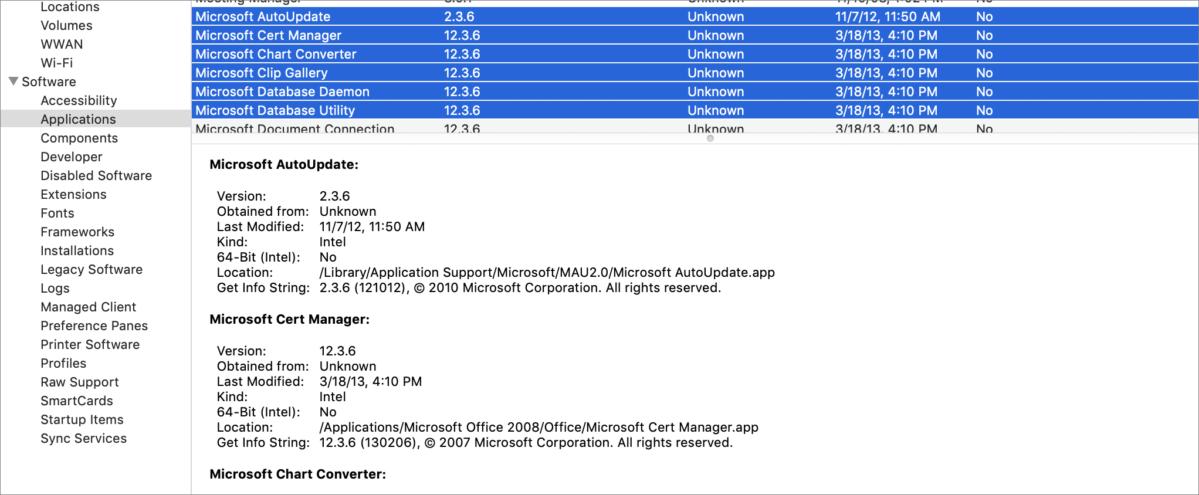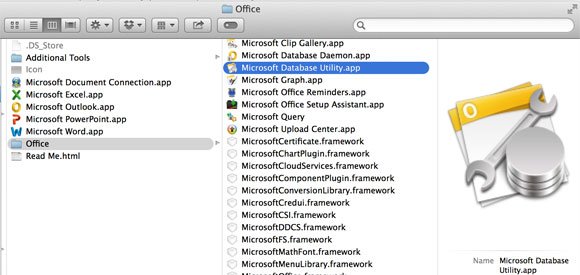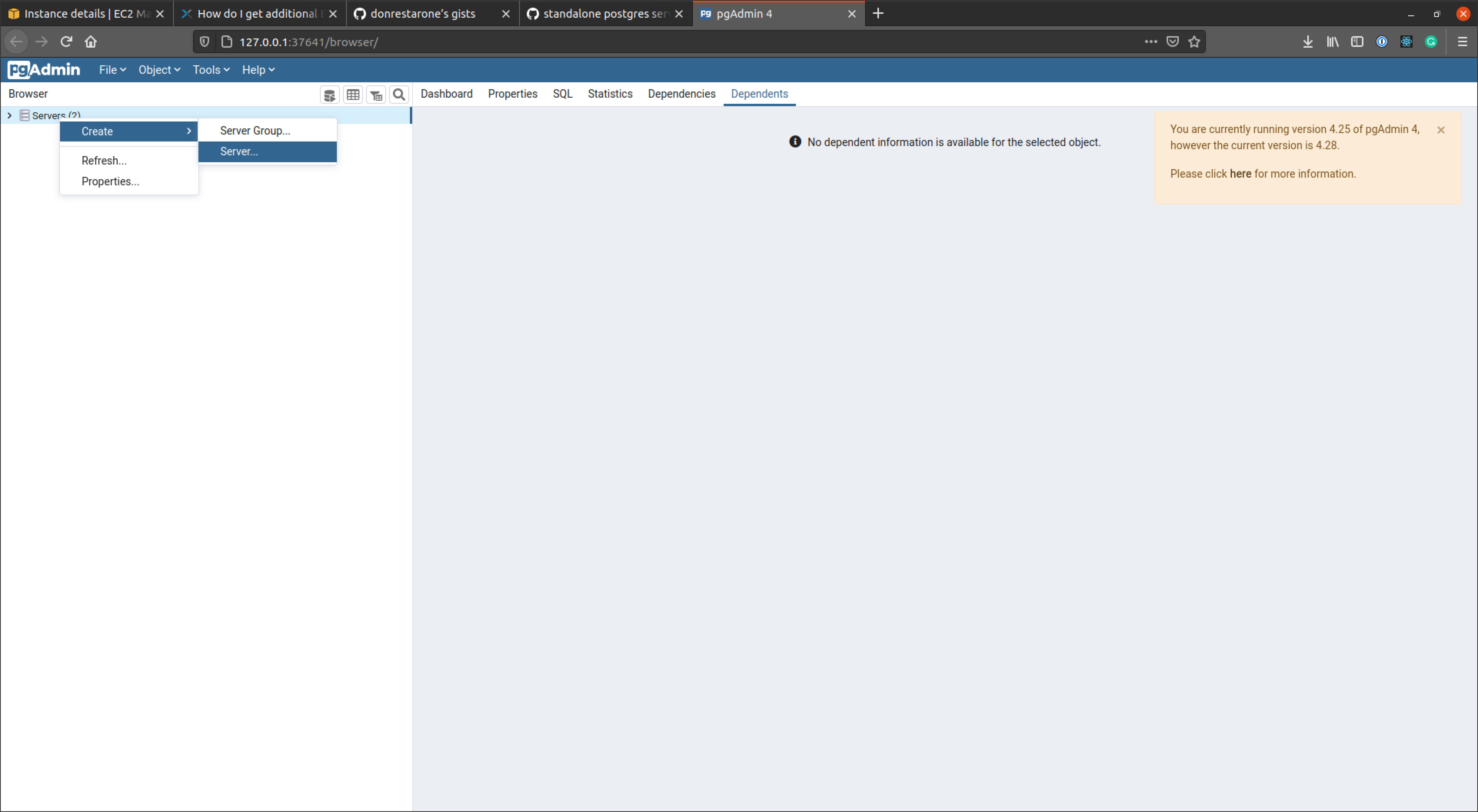- What Is Microsoft Database Daemon
- What Is Microsoft Access
- What Is Microsoft Daemon
- What Is Microsoft Database Daemon On Mac
What is Outlook Database Daemon Error? It is a networking program, which works in the background when all the MS Office applications are not running. At the time of corruption in the database, a user may not be able to access the mailbox items from the OLM file. Well three things then if rebuilding the database doesn't work. Reboot the Mac (to insure all related process are properly quit and restarted). If that doesn't work, trash the database daemon preference files from /Library/Preferences (in your user account). The name of the files start with com.microsoft.
In multitasking computer operating systems, a daemon (/ˈdiːmən/ or /ˈdeɪmən/)[1] is a computer program that runs as a background process, rather than being under the direct control of an interactive user. Traditionally, the process names of a daemon end with the letter d, for clarification that the process is in fact a daemon, and for differentiation between a daemon and a normal computer program. For example, syslogd is a daemon that implements system logging facility, and sshd is a daemon that serves incoming SSH connections.

In a Unix environment, the parent process of a daemon is often, but not always, the init process. A daemon is usually created either by a process forking a child process and then immediately exiting, thus causing init to adopt the child process, or by the init process directly launching the daemon. In addition, a daemon launched by forking and exiting typically must perform other operations, such as dissociating the process from any controlling terminal (tty). Such procedures are often implemented in various convenience routines such as daemon(3) in Unix.
Systems often start daemons at boot time that will respond to network requests, hardware activity, or other programs by performing some task. Daemons such as cron may also perform defined tasks at scheduled times.
Terminology[edit]
The term was coined by the programmers at MIT's Project MAC. According to Fernando J. Corbató, who worked on Project MAC in 1963, his team was the first to use the term daemon, inspired by Maxwell's demon, an imaginary agent in physics and thermodynamics that helped to sort molecules, stating, 'We fancifully began to use the word daemon to describe background processes that worked tirelessly to perform system chores'.[2]Unix systems inherited this terminology. Maxwell's demon is consistent with Greek mythology's interpretation of a daemon as a supernatural being working in the background. However, BSD and some of its derivatives have adopted a Christian demon as their mascot rather than a Greek daemon.[citation needed]
In the general sense, daemon is an older form of the word 'demon', from the Greek δαίμων. In the Unix System Administration HandbookEvi Nemeth states the following about daemons:[3]
Many people equate the word 'daemon' with the word 'demon', implying some kind of satanic connection between UNIX and the underworld. This is an egregious misunderstanding. 'Daemon' is actually a much older form of 'demon'; daemons have no particular bias towards good or evil, but rather serve to help define a person's character or personality. The ancient Greeks' concept of a 'personal daemon' was similar to the modern concept of a 'guardian angel'—eudaemonia is the state of being helped or protected by a kindly spirit. As a rule, UNIX systems seem to be infested with both daemons and demons.
A further characterization of the mythological symbolism is that a daemon is something that is not visible yet is always present and working its will. In the Theages, attributed to Plato, Socrates describes his own personal daemon to be something like the modern concept of a moral conscience: 'The favour of the gods has given me a marvelous gift, which has never left me since my childhood. It is a voice that, when it makes itself heard, deters me from what I am about to do and never urges me on'.[citation needed]
In modern usage, the word daemon is pronounced /ˈdiːmən/DEE-mən. In the context of computer software, the original pronunciation /ˈdiːmən/ has drifted to /ˈdeɪmən/DAY-mən for some speakers.[1]
Alternative terms for daemon are service (used in Windows, from Windows NT onwards — and later also in Linux), started task (IBM z/OS),[4] and ghost job (XDS UTS).
What Is Microsoft Database Daemon
After the term was adopted for computer use, it was rationalized as a backronym for Disk And Execution MONitor.[5]

Daemons that connect to a computer network are examples of network services.
Implementations[edit]
Unix-like systems[edit]
In a strictly technical sense, a Unix-like system process is a daemon when its parent process terminates and the daemon is assigned the init process (process number 1) as its parent process and has no controlling terminal. However, more generally, a daemon may be any background process, whether a child of the init process or not.
On a Unix-like system, the common method for a process to become a daemon, when the process is started from the command line or from a startup script such as an init script or a SystemStarter script, involves:
- Optionally removing unnecessary variables from environment.
- Executing as a background task by forking and exiting (in the parent 'half' of the fork). This allows daemon's parent (shell or startup process) to receive exit notification and continue its normal execution.
- Detaching from the invoking session, usually accomplished by a single operation,
setsid():- Dissociating from the controlling tty.
- Creating a new session and becoming the session leader of that session.
- Becoming a process group leader.
- If the daemon wants to ensure that it will not acquire a new controlling tty even by accident (which happens when a session leader without a controlling tty opens a free tty), it may fork and exit again. This means that it is no longer a session leader in the new session, and cannot acquire a controlling tty.
- Setting the root directory (/) as the current working directory so that the process does not keep any directory in use that may be on a mounted file system (allowing it to be unmounted).
- Changing the umask to 0 to allow
open(),creat(), and other operating system calls to provide their own permission masks and not to depend on the umask of the caller. - Redirecting file descriptors 0, 1 and 2 for the standard streams (stdin, stdout and stderr) to /dev/null or a logfile, and closing all the other file descriptors inherited from the parent process.
If the process is started by a super-server daemon, such as inetd, launchd, or systemd, the super-server daemon will perform those functions for the process,[6][7][8] except for old-style daemons not converted to run under systemd and specified as Type=forking[8] and 'multi-threaded' datagram servers under inetd.[6]
MS-DOS[edit]

In the Microsoft DOS environment, daemon-like programs were implemented as terminate and stay resident (TSR) software.
Windows NT[edit]
On Microsoft Windows NT systems, programs called Windows services perform the functions of daemons. They run as processes, usually do not interact with the monitor, keyboard, and mouse, and may be launched by the operating system at boot time. In Windows 2000 and later versions, Windows services are configured and manually started and stopped using the Control Panel, a dedicated control/configuration program, the Service Controller component of the Service Control Manager (sc command), the net start and net stop commands or the PowerShell scripting system.
However, any Windows application can perform the role of a daemon, not just a service, and some Windows daemons have the option of running as a normal process.
Classic Mac OS and macOS[edit]
On the classic Mac OS, optional features and services were provided by files loaded at startup time that patched the operating system; these were known as system extensions and control panels. Later versions of classic Mac OS augmented these with fully fledged faceless background applications: regular applications that ran in the background. To the user, these were still described as regular system extensions.
macOS, which is a Unix system, uses daemons. Note that macOS uses the term 'services' to designate software that performs functions selected from the Services menu, rather than using that term for daemons as Windows does.
See also[edit]
- Bounce message (also known as mailer daemon)
References[edit]
- ^ abEric S. Raymond. 'daemon'. The Jargon File. Retrieved 2008-10-22.
- ^'The Origin of the word Daemon'.
- ^'The BSD Daemon'. Freebsd.org. Retrieved 2008-11-15.
- ^'IBM Knowledge Center - Glossary of z/OS terms and abbreviations'. IBM.
- ^'Daemon Definition'. www.linfo.org.
- ^ ab
inetd(8)– FreeBSD System Manager's Manual - ^
launchd.plist(5)– Darwin and macOS File Formats Manual - ^ ab'systemd.service'. freedesktop.org. Retrieved August 25, 2012.
External links[edit]
So this application is basically about automatic update tasks which run in the background of your operating system.
It stands for the term Microsoft Auto-Update daemon. It tests whether new updates are eligible when you open a Microsoft application.
If that is the case, you will launch another program to substitute the outdated term with the latest one; it is named “Microsoft AU Daemon” and it is likely to see a prompt, possibly because it calls for a modification to your machine (installing the new software).
If you haven’t already launched the Microsoft AU daemon by double-clicking, macOS is vigilant and requests permission to operate this application:

The operating system is pretty secure for certain stuff by default, and you will be interested in anything that modifies the details on your computer.
Here in this article, we are going to discuss the important terms of Microsoft Auto update Daemons that will help you access it easily,
What is Microsoft AU Daemon?
Microsoft AU Daemon is an auto-update system that upgrades the Office installation. T
hey are secure and working in the background so you check at Microsoft servers to see if your office applications have been updated.
How to Disable It?
If you want to disable this application then you need to take a few steps that are mentioned below,
- Open the system preferences
- Choose account
- Then go to the connection inputs and select Microsoft AU Daemon
- Select delete icon and that’s how this application will be disabled from your computer
Is it Safe to Use?
Updates of Microsoft Auto are enabled in Microsoft Office and handle every System upgrade.
Autoupdate 3.8 for Microsoft. 3 is the first update in 12 months and can be used safely.
Is it a Virus or Malware?
This application is a 3rd party software that keeps track of your Microsoft software programs on your computer.
It is not a virus basically but can be considered as a malware attack.
How Does It Function in Mac?
The database of the Microsoft daemon is a tool that has the important notifications and reminders of the suite.
This supports the site of Microsoft and suggests to turn off the services by the sync service function in the Outlook program and then attempt to update the office before quitting the Outlook.
How Can I Remove It?
As the functionality of Microsoft Office programs need AU Daemon so you can not uninstall it.
The closest thing you can do, though, is to deactivate it. It is perfect whether you work on limited bandwidth, or do not want to upgrade your MS Office.
- Activate Office program of your choice
- Create a blank document
- Select Account at the top left corner of the file
- A new window would appear on your screen
- Choose Update options and select disable
- Confirm it by clicking yes
- Then restart your windows
Not only can you deactivate your Microsoft Word AU Daemon, but also all other MS Office services connected to your account by following these steps.
However, keep in mind that MS Office systems are always issued with protection fixes, not just feature updates, so Microsoft AU Daemon is activated with its own risk set
How to Quit Microsoft Auto-Update?
To uninstall the application on the Microsoft Auto-update
What Is Microsoft Access
- Select quit Microsoft auto-update from the menu bar by right-clicking the dock icon
- Choose quit options
- Moreover, you can also access the activity monitor in the folder/applications/utilities if you want to check the background phase of that particular app whether it is available.
Also Read: What is Swsetup.exe? Is it Safe or a Virus? (Short Guide)
What does the Word Daemon Refer to?
Daemons are usually tiny programs and are not explicitly interacting with the machine user, not to be mistaken with demons.
We also help to provide a service that is required by operating systems or applications.
Is it Safe to Launch Daemons?
Every aspect in this scenario that is already extracted from such files does not make a big startup change, but it will help a little bit.
Moreover, don’t tend to remove any of the items from the launch agents or directories of launch daemons, because if you do that it will unstable the Mac from triggering device crashes.
What Do Daemons Do?
The word daemon is pronounced as DEE-Muhn, is an ongoing system for the execution of the basic services requested by a computer device that it intends to obtain.

The functionality of this mechanism is to transmit data for processing
Is Daemon a Demon?
“Daemon” is also a much older version of a “demon;” daemons have no clear allegiance to good or evil; they tend only to describe a person’s temperament or character.
All Microsoft Office programs are connected to AU Daemon. It includes Word, Excel, Outlook and Publisher, PowerPoint, One Note, Access.
Every software arrives with this preinstalled program, which is activated in the background of the applications.
For instance, to guarantee the User of the recent versions of the Application Framework, AU Daemon is connected to checks for changes for all Office tasks. This software is not compelling as it is pre-installed.
Hence, we are clear about what it is. Now let us discuss another pop-up issue that occurs several times when you use any Microsoft office application.
Whenever you launch a Microsoft office program on MAC OS, you can experience pop up every time stating.
How to Disable Microsoft Auto-Update Daemon on MAC?
To disable this application in MAC you need to take a few steps that are mentioned below,
- Open the system preferences
- Choose account
- Then go to the connection inputs and select Microsoft AU Daemon
- Select delete icon and that’s how this application will be disabled from your computer
So basically it is an auto-update tool for Microsoft Office programs. It runs in the background ensuring the stability of the operating system with the latest updates, activating them and replacing the old version with the new one.
It is connected with all the Microsoft Office applications as it helps them run smoothly and efficiently.
What Is Microsoft Daemon
Conclusion!
What Is Microsoft Database Daemon On Mac
Having said that, the analysis for the Microsoft AU daemon came to an end. We hope that we were able to educate you with all the important aspects related to it.